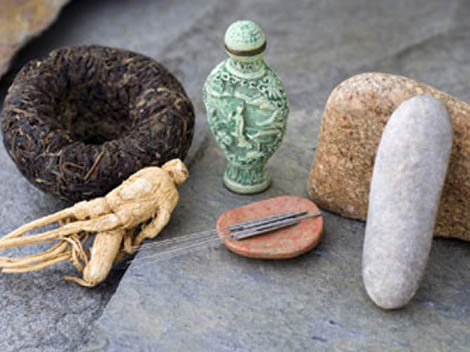more>>More News
- National Day
- ways to integrate into Chinese style life
- Should they be in the same university with me?!!
- Chinese Ping Pang Legend: the Sun Will Never Set
- A Glance of those Funny University Associations
- mahjong----The game of a brand new sexy
- Magpie Festival
- Park Shares Zongzi for Dragon Boat Festival
- Yue Fei —— Great Hero
- Mei Lanfang——Master of Peking Opera
Ancient Chinese Medical Theories
By admin on 2015-01-19
The medical theories in ancient China had an independent
system . It developed through a historical course from primality to maturity ,
from simplicity to complication and from chaos to unification . With the
appearance of the “Yellow Emperor’s Canon of Internal Medicine” , a more
systematic theory of the Chinese medicine came into existence , based on the
practitioners’ experiences and the development of natural philosophy in the
Spring-Autumn-Warring States period . After the inception of the theoretic system , the Chinese
medicine progressed further . Many renowned medical practitioners emerged . They
proposed different medical theories and formed different schools of medicine .
They wrote many medical works that still have a guiding clinical importance now
. The “Yellow Emperor's Canon of Internal Medicine” was
compiled from the Warring States Period until the Western Han Dynasty . It was
the earliest work on medical theories . It discussed the issues of viscera ,
channels and collaterals , pathogeny , pathology , diagnostics , treatment ,
principles , acupuncture , moxibustion , hygiene , etc ., and referred to the
conceptions of the ancient Chinese philosophies , such as Jing (essence) , Qi
(vitality) , Yin and Yang (negative and positive) and Five Elements (metal ,
wood , water , fire and earth) , incorporating the ancient materialism and
dialectics . The theoretic system of the Chinese medicine had its own scientific
implications . There were eight noted competing medical schools of the
Chinese medicine as the following : the Eight Typhoid Masters Schools prior to
the Song-Jin Dynasties , the Three Typhoid Schools in the Ming-Qing Dynasties ,
the Hejian School , the Yishui School , the Febrile-Disease School and the
Confluent School . As pioneers of the medical elite , the Eight Typhoid Masters
comprised Wang Shuhe in Jin (4th century) , Sun Simiao in Tang , Han Dihe, Zhu
Hong , Pang Anshi , Xu Shuwei and Guo Yong in Song , and Cheng Wuji in Jin .
They expounded from different angles the gist of diagnosis and treatment
proposed in the “Treatment of Typhoid” , influencing greatly the later doctors
in treating typhoid . The Three Typhoid Schools in the Ming and Qing Dynasties are
referred to as the Wrong Edition Revision School , the Old Edition Supporting
School and Dialectical School . The first school held that there were certain
mistakes in the existing old edition and that it should be revised , sponsored
by Fang Youzhi at the end of the Ming Dynasty and Yu Jiayan in the beginning of
the Qing Dynasty , and a number of doctors followed them afterwards . The second
school advocated supporting the old edition . There were also many doctors in
this school , who affirmed basically the edition of “Treatment of Typhoid”
edited by Wang Shuhe and the “Annotations and Treatment of Typhoid” written by
Cheng Wuji . The third school advocated studying the “Treatment of Typhoid” from
various angles , and treating typhoid dialectically . The Hejian School in Song came into shape under specific
historic background and social environment . At the outset they discovered the
feverish pathology of typhoid and cured it with chilly-natured herbs . They were
widely known for treating later typhoid by countering vicious symptoms and
nourishing body fluid and blood , and were divided into two sub-schools : One
stressed countering vicious symptoms . The other stressed nourishing body fluid
and blood . The school broke new ground theoretically and achieved important
successes in clinical treatment . They prompted both pathological study and
theoretical study in Chinese medicine and provided foundation for the emergence
of the Febrile Disease School in Ming and Qing . It was one of the most
influential medical schools in the history of Chinese medicine . The Yishui School , came into shape on the basis of the
study of externally affected febrile diseases carried out by the past doctors .
It was fully developed in Ming and Qing , and was divided into the epidemic
febrile disease school and febrile disease school . The former carried out
researches on epidemic febrile diseases . The latter carried out researches on
common febrile diseases (including the damp febrile diseases) . They made
respective important contributions in that they detached he externally affected
febrile disease from the bondage of the “Treatment of Typhoid” . So , they
played a far-reaching role in the development of the Chinese medicine
.
- Contact Us
-
Tel:
0086-571-88165708
0086-571-88165512E-mail:
admission@cuecc.com
- About Us
- Who We Are What we do Why CUECC How to Apply
- Address
- Study in China TESOL in China
Hangzhou Jiaoyu Science and Technology Co.LTD.
Copyright 2003-2024, All rights reserved




 Chinese
Chinese
 English
English
 Korean
Korean
 Japanese
Japanese
 French
French
 Russian
Russian
 Vietnamese
Vietnamese
